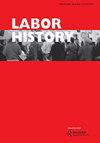瑞典最后一代奶牛场女工:性别、技能和职业认同
IF 0.7
4区 管理学
Q1 HISTORY
引用次数: 0
摘要
摘要瑞典乳制品行业性别分工的历史与西欧和北美其他地区不同。当牛奶加工集中化和机械化时,熟练的奶制品工作仍掌握在妇女手中。然而,当该行业在两次世界大战期间合并时,这一职业经历了一个快速的男性化过程,与此同时,工作被取消了,需要更少的体力劳动。挤奶女工对这种转变有何反应?本文分析了瑞典最后一代奶牛场女工的自传体,她们在被视为女性时进入了这一职业。在他们的教育和职业生涯中,他们形成了强烈的职业认同感,并保留了他们熟练劳动的尊严、价值和女性感。然而,最终,当雇主在重组整个行业的同时改变性别分工时,他们无法捍卫自己的集体地位。本文章由计算机程序翻译,如有差异,请以英文原文为准。
The last generation of dairymaids: gender, skill, and occupational identity in Sweden
ABSTRACT The history of the gender division of labor in the Swedish dairy industry differs from its course elsewhere in Western Europe and in North America. When milk processing was centralized and mechanized, skilled dairy work remained in the hands of women. When the industry consolidated during the interwar period, however, the occupation underwent a rapid process of masculinization at the same time that the work was deskilled and demanded less bodily toil. How did dairymaids respond to this shift? This article analyzes the autobiographies of the last generation of Swedish dairymaids who entered the occupation when it was regarded as womanly. In their education and careers, they developed a strong occupational identity and retained their sense of the dignity, value, and womanliness of their skilled labor. Ultimately, however, they were unable to defend their collective position when the employers transformed the gender division of labor while restructuring the entire industry.
求助全文
通过发布文献求助,成功后即可免费获取论文全文。
去求助
来源期刊

Labor History
Multiple-
CiteScore
1.00
自引率
28.60%
发文量
44
期刊介绍:
Labor History is the pre-eminent journal for historical scholarship on labor. It is thoroughly ecumenical in its approach and showcases the work of labor historians, industrial relations scholars, labor economists, political scientists, sociologists, social movement theorists, business scholars and all others who write about labor issues. Labor History is also committed to geographical and chronological breadth. It publishes work on labor in the US and all other areas of the world. It is concerned with questions of labor in every time period, from the eighteenth century to contemporary events. Labor History provides a forum for all labor scholars, thus helping to bind together a large but fragmented area of study. By embracing all disciplines, time frames and locales, Labor History is the flagship journal of the entire field. All research articles published in the journal have undergone rigorous peer review, based on initial editor screening and refereeing by at least two anonymous referees.
 求助内容:
求助内容: 应助结果提醒方式:
应助结果提醒方式:


